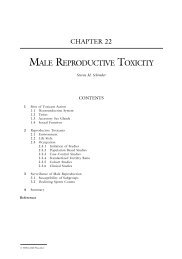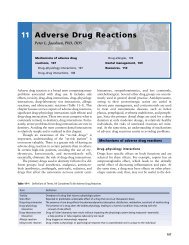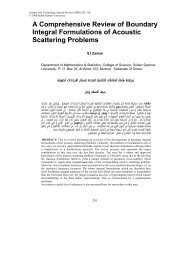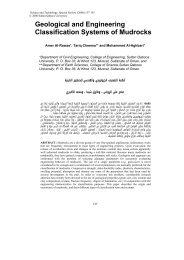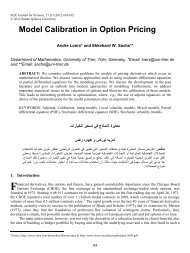81. Neonatal Hypotonia
81. Neonatal Hypotonia
81. Neonatal Hypotonia
- No tags were found...
Create successful ePaper yourself
Turn your PDF publications into a flip-book with our unique Google optimized e-Paper software.
532 / The Hospitalized ChildTABLE 81-4.NewbornMajor Causes of Central <strong>Hypotonia</strong> in theI. <strong>Hypotonia</strong> is present at birthBrain and spinal cord injury or trauma: hypoxic-ischemic encephalopathyand intracranial hemorrhageGenetic and chromosomal: Down syndrome and Prader-Willi syndromeCerebral dysgenesis and other structural cerebral abnormalitiesPeroxisomal disorders: cerebrohepatorenal syndrome (Zellwegersyndrome) and neonatal adrenoleukodystrophyOther rare metabolic or genetic conditions: generalized GM1, gangliosidosis,familial dysautonomia, Cohen syndrome, and oculocerebrorenalsyndrome (Lowe syndrome)Benign congenital hypotoniaII. <strong>Hypotonia</strong> usually develops shortly after birthSepsis, including meningitis and encephalitisMetabolic derangements or disordersEndocrine: hypothyroidismDrug intoxicationmosome 15 from the mother (maternal uniparental disomy)may also occur, often in the context of advancedmaternal age. In addition to profound hypotonia andhypogonadism, affected infants have severe feeding difficultiesthat may necessitate prolonged nasogastric tube feeding.Normal respiratory function is helpful for distinguishingthis condition from other disorders of the motor unit. Astime progresses, the muscle tone becomes normal and insatiablehunger, obesity, and mental retardation become evident.Diagnosis is confirmed by chromosome analysis withprophase banding. Specific treatment is not available.Other genetic conditions that present with neonatalhypotonia and feeding difficulties include familial dysautonomia,Cohen syndrome, and oculocerebrorenal syndrome(Lowe syndrome).Peroxisomal DisordersThese neurodegenerative disorders are caused by dysfunctionof peroxisomes, which are subcellular organelles thatassist in the catabolism of very-long-chain fatty acids,pipecolic acid, dicarboxylic acid, and phytanic acid and inthe synthesis of plasmalogens. The most reliable indicatorof peroxisomal disorders is an elevation of very-long-chainfatty acids in blood. Other biochemical abnormalities arehyperpipecolic acidemia and aciduria. Mutations of thePEX1 gene, which are responsible for more than 50% ofcases, may be analyzed in fibroblast cultures and may permitprenatal diagnosis by chorionic villus sampling.Zellweger syndrome (cerebrohepatorenal syndrome) ischaracterized by profound hypotonia, seizures, arthrogryposiswith camptodactyly (limited finger extension) andflexion deformities of knees and ankles, diminished tendonreflexes, and craniofacial dysmorphic features (eg, highforehead, hypertelorism, and unusual fullness of cheeks). Inaddition, there are abnormalities of other organs, includingbiliary cirrhosis, renal cysts, epiphyseal stippling, and retinaldegeneration. <strong>Neonatal</strong> adrenoleukodystrophy is anautosomal recessive peroxisomal disorder with hypotonia,failure to thrive, hepatomegaly, retinitis pigmentosa, andprogressive neurologic deterioration. Adrenal glands arehypoplastic but adrenal failure does not occur. There is nospecific treatment for peroxisomal disorders and deathoften occurs in early infancy.Benign Congenital <strong>Hypotonia</strong>The term “benign congenital hypotonia” has been used todescribe infants who are hypotonic at birth but without aspecific underlying diagnosis and whose tone normalizesduring early childhood. Most probably the term encompassesmany different pathologic entities and affectedinfants have an increased incidence of other features ofcerebral dysfunction (eg, learning difficulties). In these situations,ongoing effort should be directed toward establishmentof a more specific diagnosis.Peripheral Causes of <strong>Hypotonia</strong>Abnormalities at any level of the motor unit may presentwith hypotonia in association with weakness and diminishedtendon reflexes. The major disorders are listed inTable 81-5.Anterior Horn Cell DiseasesThese disorders, specifically spinal muscular atrophy type 1(Werdnig-Hoffmann disease) account for approximatelyTABLE 81-5.Major Peripheral Causes of <strong>Hypotonia</strong>Level of anterior horn cell (lower motor neuron)Spinal muscular atrophy type I (Werdnig-Hoffman disease)Glycogen storage disease type II (Pompe’s disease)Hypoxic-ischemic injury<strong>Neonatal</strong> poliomyelitisLevel of peripheral nerveDemyelinating neuropathies: hereditary or chronic inflammatoryNeuroaxonal dystrophy (rare)MitochondrialLysosomal (Krabbe’s disease)Level of neuromuscular junctionMyasthenia: neonatal transient or congenital myasthenic syndromeToxic-metabolic: hypermagnesemia and aminoglycosidesInfant botulismLevel of the muscleMuscular dystrophy: congenital myotonic and congenital muscular dystrophyMetabolic myopathies: mitochondrial, glycogen disorder, and lipid disordersCongenital myopathies: nemaline (rod body), myotubular (centronuclear),and otherCurrent Management in Child Neurology, Third Edition© 2005 Bernard L. Maria, All Rights Reserved <strong>Neonatal</strong> <strong>Hypotonia</strong>BC Decker Inc Pages 528–534





